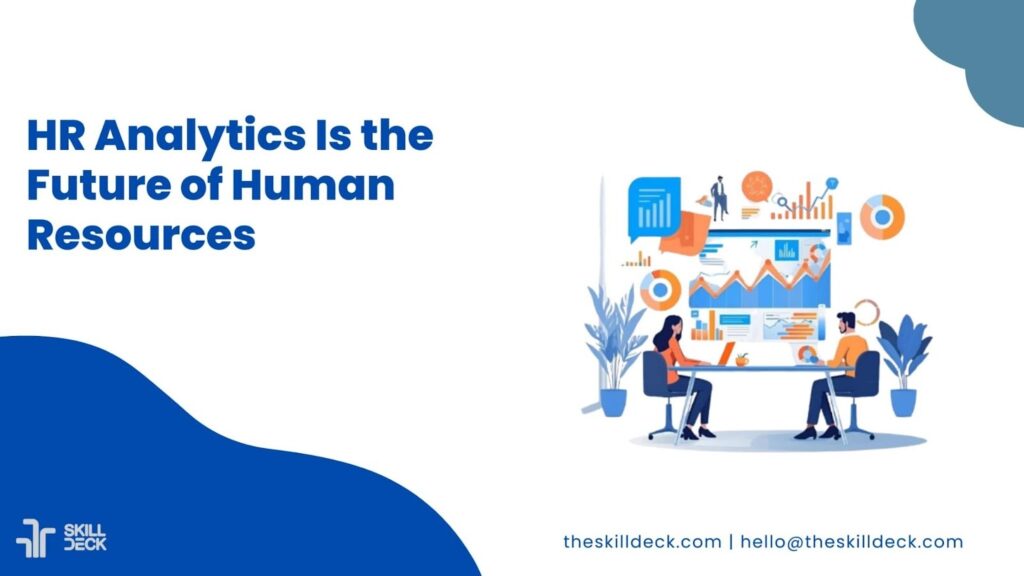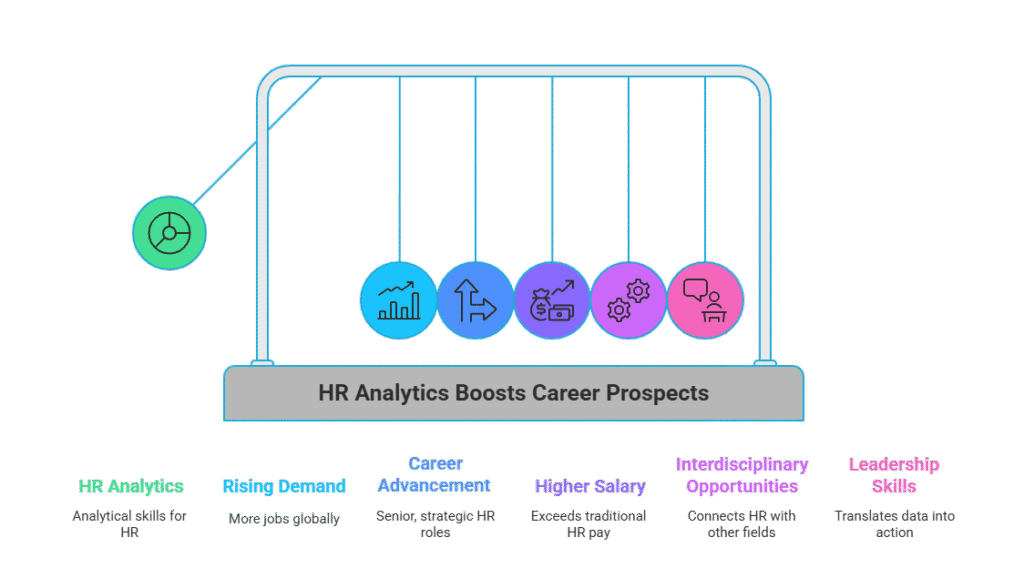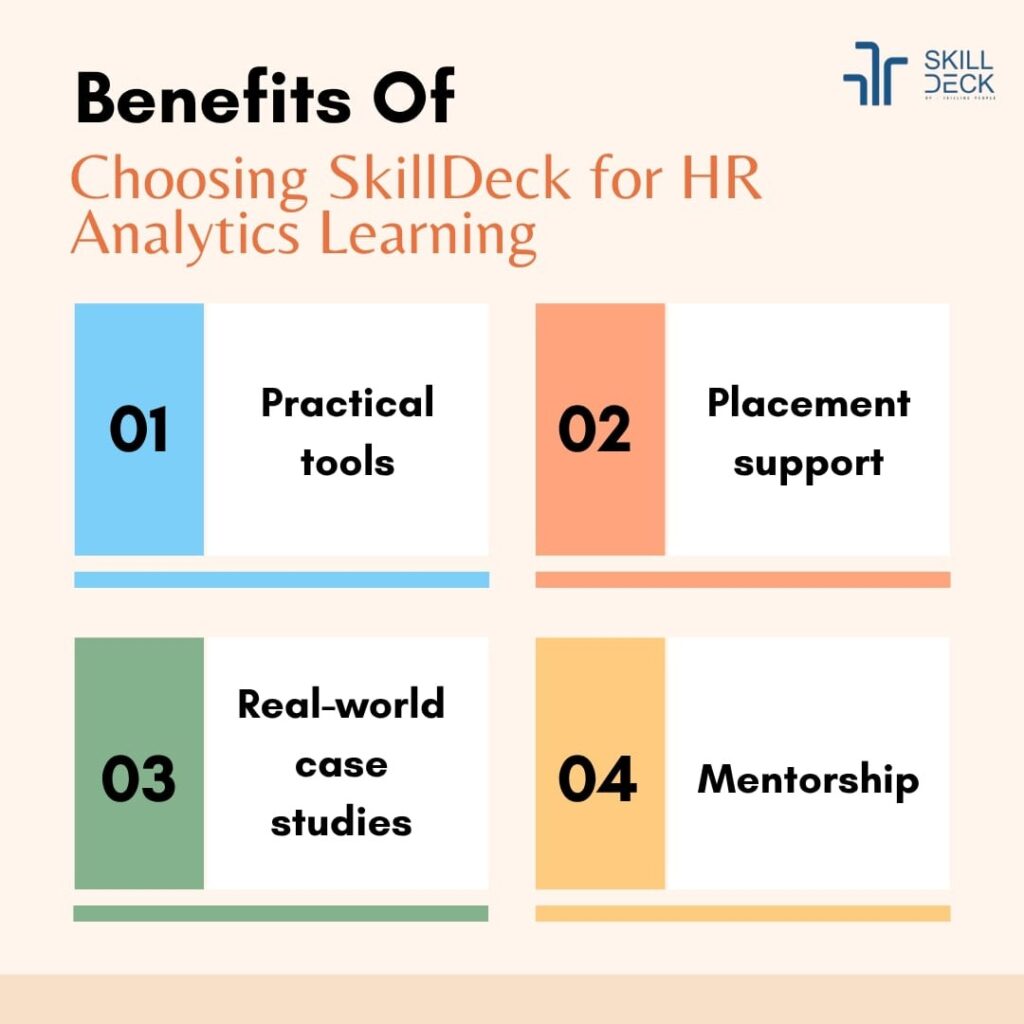
Modern organizations no longer rely on instinct or experience alone to make people-related decisions. Instead, they turn to HR Analytics, which is the practice of using data, statistical models, and digital tools to gain actionable insights into the workforce. In essence, HR Analytics transforms HR into a strategic, evidence-based business function.
A study published at ResearchGate, reveals that companies using data analytics see 42.3% improvement in risk assessment and have an 85.7% accuracy in detecting potential employee turnover. That said, HR leaders can improve employee retention and engagement with data-driven decision-making skills.
What Is HR Analytics?
HR Analytics, also known as People Analytics, involves gathering and analyzing employee data to understand workforce behavior and performance. Unlike traditional HR, which focuses on qualitative evaluations, HR Analytics blends quantitative data with HR expertise to support better decision-making.
Complete HR Analytics Work Cycle

The HR Analytics process involves several key steps that build upon each other to create a complete, data-driven approach.
- Data Collection: Gathering structured and unstructured data such as attendance logs, performance ratings, recruitment metrics, and feedback surveys. It is critical to ensure accuracy, consistency, and privacy compliance during this phase.
- Data Analysis: Using statistical models and visualization tools like Excel, Power BI, or Python to identify patterns, relationships, and anomalies. This step transforms raw data into meaningful insights that HR leaders can interpret.
- Interpretation: Translating findings into strategic HR actions, such as revising hiring criteria, redesigning onboarding programs, or improving training modules. The insights guide evidence-based changes rather than intuition-driven adjustments.
- Decision Making: Implementing strategies backed by data to improve performance, retention, and engagement. Continuous monitoring helps evaluate the effectiveness of these decisions and refine future HR strategies
Additional components include data validation, which ensures reliability, data visualization, which communicates findings clearly to stakeholders, and feedback loops, where outcomes inform future data collection efforts.
According to the Institute Of Product Leadership, organizations using people Analytics are 120% more likely to outperform their competitors in talent acquisition, development, and retention.
Why HR Analytics Is Important in Today’s Workforce?

Enhancing Workforce Planning and Forecasting
HR Analytics helps organizations anticipate future workforce needs based on hiring trends, skill gaps, and turnover data. This foresight enables HR to plan for succession and prepare strategic hiring pipelines.
Supporting Diversity and Inclusion Goals
By analyzing demographic and engagement data, HR teams can identify diversity gaps and design inclusive policies. This ensures equitable growth opportunities and fosters a more balanced, productive workplace.
Data-Driven Decision Making
Data eliminates guesswork from HR functions. Using analytics, HR professionals can predict employee turnover, identify top performers, and optimize recruitment campaigns. Gartner’s 2023 HR Survey shows that 70% of organizations that integrate analytics into HR decision-making see measurable productivity improvements.
Boosting Employee Retention and Engagement
Employee engagement data helps HR teams understand why people stay or leave. For instance, analyzing exit interviews and engagement survey scores can reveal patterns that help prevent attrition. Companies like Google and IBM have leveraged HR Analytics to predict flight risks and enhance retention strategies.
Measuring ROI of HR Initiatives
Analytics allows HR departments to quantify the return on investment for training, performance incentives, and hiring programs. For example, tracking post-training performance improvements can demonstrate the value of learning initiatives, helping HR leaders secure budget approvals.
Why Is HR Analytics Needed? Career Benefits of Learning HR Analytics

Rising Demand in India and Globally
The demand for HR professionals with analytical capabilities continues to surge across industries. Organizations increasingly rely on HR Analytics to understand workforce trends, optimize recruitment, and predict employee performance.
This rise in demand translates into abundant career opportunities in India and globally. As more businesses adopt digital HR systems, those equipped with analytics knowledge will find themselves leading HR transformation projects that directly influence organizational success.
Career Advancement Opportunities
Developing HR Analytics expertise opens doors to senior roles such as HR Strategy Consultant, Workforce Planning Lead, or HR Business Partner with advanced data specialization. These positions require a mix of people management and analytical proficiency.
Professionals who combine traditional HR skills with statistical and visualization capabilities can bridge the gap between HR and business strategy, contributing to long-term corporate goals.
Salary and Job Prospects
Compensation for HR professionals with analytics expertise often surpasses traditional HR roles. According to Glassdoor India, HR Analysts earn between ₹4–10 LPA, with senior data-driven HR specialists exceeding ₹15 LPA. Multinational companies and consulting firms are particularly keen to hire professionals who can quantify workforce ROI and interpret data for leadership insights, making HR Analytics a financially rewarding career path.
Expanding Interdisciplinary Opportunities
HR Analytics connects HR with technology, finance, and operations. By mastering it, professionals can collaborate with IT teams on HRIS integration, support financial departments in budgeting, or assist in risk management by predicting talent shortages. This cross-functional impact expands career horizons beyond HR departments, creating diverse growth possibilities in corporate strategy and business analysis.
Building Strategic and Leadership Skills
HR professionals skilled in analytics also develop leadership abilities by translating complex data into actionable business narratives. They learn to communicate insights to top management, influencing strategic decisions. This analytical leadership fosters credibility within organizations and positions HR professionals as key contributors to corporate planning and innovation.
Top Tools Used in HR Analytics
Mastering HR Analytics requires familiarity with leading data tools, including:
| Tool / Platform | Primary Use | Key Benefit |
| Power BI / Tableau | Visualizing workforce trends and KPI dashboards | Enables clear, interactive visualization of HR metrics and performance insights |
| Python & R | Conducting predictive modeling and advanced statistical analysis | Facilitates deep data exploration and predictive HR analytics |
| Advanced Excel | Managing, cleaning, and analyzing HR data efficiently | Offers flexible, accessible data handling for quick HR analysis |
| SAP SuccessFactors / Workday | Integrating HR processes with analytics for enterprise-scale operations | Connects analytics with HR systems for better strategic workforce management |
Learning these tools empowers HR professionals to make informed, measurable contributions to business success.
Key Skills Required In HR Analytics
Aspiring HR Analytics professionals need a strong foundation across multiple domains.
1. Expertise In Excel, Power BI, SQL, and Python
You should learn to collect, clean, analyze, and interpret HR metrics such as employee engagement, turnover, and hiring efficiency.
Knowledge of the tools mentioned above is essential for processing and visualizing data, while knowledge of HR concepts ensures accurate interpretation.
2. Communication
Communication skills are equally vital since professionals need to present insights clearly to business leaders and HR stakeholders.
3. Ethical Data-handling Capabilities
Developing critical thinking and cautious data handling skills, and understanding predictive analytics enhances one’s ability to draw meaningful insights, ensure data integrity, and make informed HR decisions that drive expected business outcomes.
HR Analytics Learning Path for Beginners
Beginners can start by mastering HR data management in Excel before progressing to advanced visualization using Power BI or Tableau. Going a step further, by learning programming basics in Python or R will help in building statistical and predictive models.
Many professionals strengthen their journey by pursuing specialized HR Analytics certification programs, which combine theoretical concepts with hands-on project work.
You can also enroll in Internships or volunteer for small-scale projects where you will get the chance to work with real HR datasets. This can provide practical experience and provide valuable career clarity.
Why Choose SkillDeck for HR Analytics Learning?

SkillDeck’s HR Analytics Certification Course is designed for working professionals and students who want to build a future-ready HR career. The program covers:
- Practical tools: Excel, Power BI, and Python for HR applications
- Placement support: Guidance and assistance with job opportunities
- Real-world case studies: Learn from scenarios across industries
- Mentorship: Expert-led sessions for both technical and strategic growth
With SkillDeck, learners gain the skills needed to make HR decisions backed by reliable data.
Conclusion
HR Analytics is reshaping the future of human resources by turning data into actionable insights. It helps organizations make fair, objective, and high-impact decisions that improve performance and retention. For professionals aiming to future-proof their careers, mastering HR Analytics is no longer optional — it’s essential.
Also, explore SkillDeck’s other certified HR Courses to gain the expertise employers value most.
FAQs About HR Analytics
- What Is The Purpose Of HR Analytics?
HR Analytics looks at employee data to help make choices about hiring and retaining employees, keeping them engaged, and measuring their performance. It helps businesses ensure that their employee plans and expectations are in line with their business goals.
- Is A Career In HR Analytics Good In India?
Yes. The digital transformation of HR departments has led to a huge increase in demand for HR Analytics professionals in India, especially in the IT, consulting, and finance fields.
- What Skills Do I Need To Start With HR Analytics?
You need to know a lot about Human Resource Management and be good with technology, like Excel, Power BI, and Python. Both analytical thinking and data visualization are very important parts of an HR Analytics professional’s job profile.
- What Are The Best Tools For People Who Are New To HR Analytics?
People who are just starting out can use Excel and Power BI before moving on to Python or R for more advanced analytics.
- How Can I Learn About HR Analytics Online?
You can sign up for certified programs like SkillDeck’s HR Analytics Certification Course, where you get real-world projects and practical tools experience, together with complete post-certification placement support.
